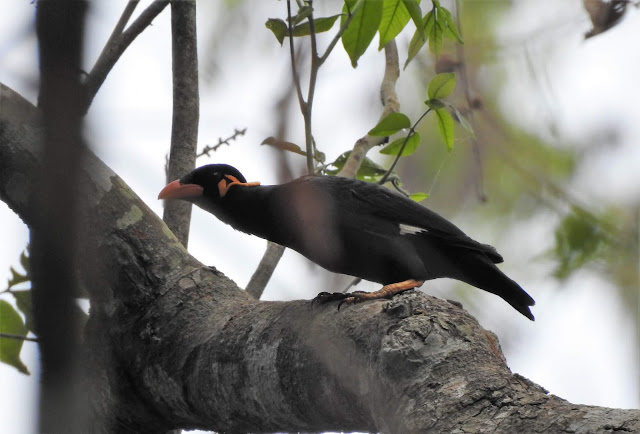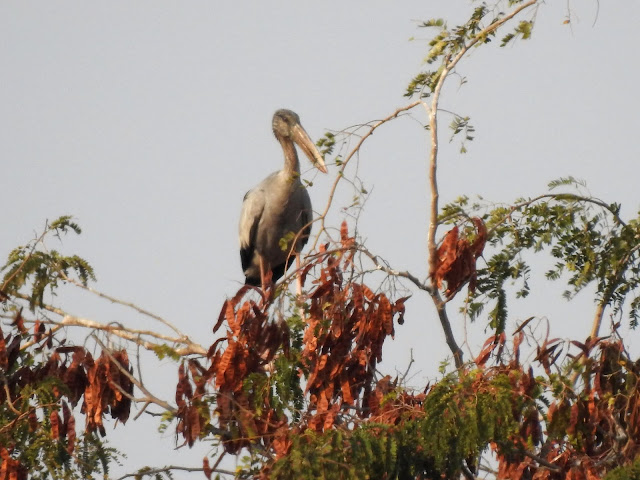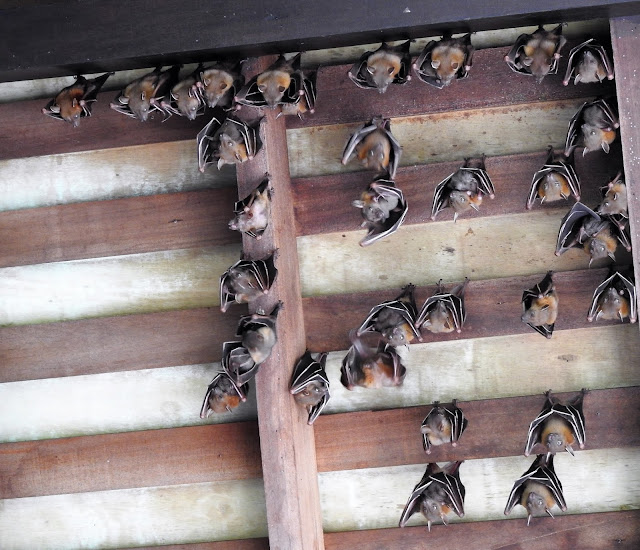 |
| BIRD OF THE DAY!!! - Forest Wagtail |
Today we had our first full day in Cambodia and it was a very full day indeed.
Kicked off at 5am for a 5-30am departure with the aim being sun rise at the famous Angkor Wat. Our timing was good however the cloud cover and perhaps smoke haze from dry season grass fires conspired to rob us of the 'post card memorable scene'. It is pretty fascinating though even without sublime morning light. And it was interesting, too, to see the world's people viewing this wonderful World Heritage Monument.
 |
| Add caption |
From Wikipedia;
One of the first Western visitors to the temple was António
da Madalena, a Portuguese friar who visited in 1586 and said that it "is
of such extraordinary construction that it is not possible to describe it with
a pen, particularly since it is like no other building in the world. It has
towers and decoration and all the refinements which the human genius can
conceive of."
Angkor Wat ("Capital Temple") is a temple
complex in Cambodia and one of the largest religious monuments in the world, on
a site measuring 162.6 hectares. Originally constructed as a Hindu temple
dedicated to the god Vishnu for the Khmer Empire, it was gradually transformed
into a Buddhist temple towards the end of the 12th century. It was built by the
Khmer King Suryavarman II in the early 12th century in Yaśodharapura
(present-day Angkor), the capital of the Khmer Empire, as his state temple and
eventual mausoleum. Breaking from the Shaiva tradition of previous kings,
Angkor Wat was instead dedicated to Vishnu. As the best-preserved temple at the
site, it is the only one to have remained a significant religious centre since
its foundation. The temple is at the top of the high classical style of Khmer
architecture. It has become a symbol of Cambodia, appearing on its national
flag, and it is the country's prime attraction for visitors.
Angkor Wat is a unique combination of the temple mountain (the standard design for the empire's state temples) and the later plan of concentric galleries. The construction of Angkor Wat also suggests that there was a celestial significance with certain features of the temple. This is observed in the temple's east-west orientation, and lines of sight from terraces within the temple that show specific towers to be at the precise location of the sunrise on a solstice. The temple is a representation of Mount Meru, the home of the gods: the central quincunx of towers symbolises the five peaks of the mountain, and the walls and moat symbolise the surrounding mountain ranges and ocean.
The scale of the place is amazing; The outer wall, 1,024 m by 802 m and 4.5 m high, is surrounded by a 30 m apron of open ground and a moat 190 m wide and over 5 kilometres in perimeter. Access to the temple is by an earth bank to the east and a sandstone causeway to the west; the latter, the main entrance, is a later addition, possibly replacing a wooden bridge. There are gopuras at each of the cardinal points; the western is by far the largest and has three ruined towers. Glaize notes that this gopura both hides and echoes the form of the temple proper. Under the southern tower is a statue of Vishnu, known as Ta Reach, which may originally have occupied the temple's central shrine. Galleries run between the towers and as far as two further entrances on either side of the gopura often referred to as "elephant gates", as they are large enough to admit those animals. These galleries have square pillars on the outer (west) side and a closed wall on the inner (east) side. The ceiling between the pillars is decorated with lotus rosettes; the west face of the wall with dancing figures; and the east face of the wall with balustered windows, dancing male figures on prancing animals, and devatas, including (south of the entrance) the only one in the temple to be showing her teeth.
 |
| Add caption |
 |
| Add caption |
 |
| Add caption |
 |
| Add caption |
Angkor Wat is a unique combination of the temple mountain (the standard design for the empire's state temples) and the later plan of concentric galleries. The construction of Angkor Wat also suggests that there was a celestial significance with certain features of the temple. This is observed in the temple's east-west orientation, and lines of sight from terraces within the temple that show specific towers to be at the precise location of the sunrise on a solstice. The temple is a representation of Mount Meru, the home of the gods: the central quincunx of towers symbolises the five peaks of the mountain, and the walls and moat symbolise the surrounding mountain ranges and ocean.
The scale of the place is amazing; The outer wall, 1,024 m by 802 m and 4.5 m high, is surrounded by a 30 m apron of open ground and a moat 190 m wide and over 5 kilometres in perimeter. Access to the temple is by an earth bank to the east and a sandstone causeway to the west; the latter, the main entrance, is a later addition, possibly replacing a wooden bridge. There are gopuras at each of the cardinal points; the western is by far the largest and has three ruined towers. Glaize notes that this gopura both hides and echoes the form of the temple proper. Under the southern tower is a statue of Vishnu, known as Ta Reach, which may originally have occupied the temple's central shrine. Galleries run between the towers and as far as two further entrances on either side of the gopura often referred to as "elephant gates", as they are large enough to admit those animals. These galleries have square pillars on the outer (west) side and a closed wall on the inner (east) side. The ceiling between the pillars is decorated with lotus rosettes; the west face of the wall with dancing figures; and the east face of the wall with balustered windows, dancing male figures on prancing animals, and devatas, including (south of the entrance) the only one in the temple to be showing her teeth.
The outer wall encloses a space of 820,000 square
metres, which besides the temple proper was originally occupied by the city
and, to the north of the temple, the royal palace. Most of the area is now
covered by forest.
The temple stands on a terrace raised higher than the
city. It is made of three rectangular galleries rising to a central tower,
each level higher than the last. Mannikka interprets these galleries as being
dedicated to the king, Brahma, the moon, and Vishnu.
Of course we went birding around the temple complex and, it is fair to say, that we did pretty well. The main targets of Forest Wagtail, Hainan Blue Flycatcher, White throated rock thrush and Blue Rock Thrush were all seen pretty well.
In addition we got good views of Asian Barred Owlet, Asian Brown and Taiga Flycatchers, Black naped Monarch, Linneated & Coppersmith Barbets, Greater Racket tailed, Hair crested and Ashy Drongoes, Hill Mynas, Pale legged Warbler, Shikra - to name a few.
We then visited Ta Promb – This is the tomb raider temple.
The temple is famous for being in beautiful disrepair. The decay provided by
the years and the endless growth od surrounding fig trees strangling the
temple’s rocks as effectively as they throttle their tree hosts. The roots of
the trees wind serpentine along the walls and through them and cascades of
roots curtain other of the temple’s former walls. Parrots are noticeable here;
Alexandrine and Red chested The latter being the most common and conspicuous.
 |
| Add caption |
 |
| Add caption |
 |
| Add caption |
 |
| Add caption |
 |
| Add caption |
 |
| Add caption |
From Wikipedia;
Ta Prohm is the modern name of the temple at Angkor, Siem Reap Province, Cambodia, built in the Bayon style largely in the late 12th and early 13th centuries and originally called Rajavihara. Located approximately one kilometre east of Angkor Thom and on the southern edge of the East Baray, it was founded by the KhmerKing Jayavarman VII[as a Mahayana Buddhist monastery and university. Unlike most Angkorian temples, Ta Prohm is in much the same condition in which it was found: the photogenic and atmospheric combination of trees growing out of the ruins and the jungle surroundings have made it one of Angkor's most popular temples with visitors. UNESCO inscribed Ta Prohm on the World Heritage List in 1992. Today, it is one of the most visited complexes in Cambodia’s Angkor region.
Ta Prohm is the modern name of the temple at Angkor, Siem Reap Province, Cambodia, built in the Bayon style largely in the late 12th and early 13th centuries and originally called Rajavihara. Located approximately one kilometre east of Angkor Thom and on the southern edge of the East Baray, it was founded by the KhmerKing Jayavarman VII[as a Mahayana Buddhist monastery and university. Unlike most Angkorian temples, Ta Prohm is in much the same condition in which it was found: the photogenic and atmospheric combination of trees growing out of the ruins and the jungle surroundings have made it one of Angkor's most popular temples with visitors. UNESCO inscribed Ta Prohm on the World Heritage List in 1992. Today, it is one of the most visited complexes in Cambodia’s Angkor region.
 |
| Add caption |
 |
| Add caption |
 |
| Add caption |
And then the Bayon Temple, located in the centre of the
Angkor Thom. This depicts, among other things, huge smiling and serene
faces and again, these have become symbols of Cambodia. There are also some large
carved walls depicting war – Cambodian triumphs over the Vietnamese [southern]
and their Chinese allies. As well as everyday scenes of Cambodian life.
From Wikipedia;
The Bayon (Prasat Bayon) is a richly decorated Khmer temple. Built in the late 12th or early 13th century as the state temple of the Mahayana Buddhist King Jayavarman VII the Bayon stands at the centre of Jayavarman's capital, Angkor Thom. Following Jayavarman's death, it was modified and augmented by later Hindu and Theravada Buddhist kings in accordance with their own religious preferences.
The Bayon's most distinctive feature is the multitude of serene and smiling stone faces on the many towers which jut out from the upper terrace and cluster around its central peak. The temple has two sets of bas-reliefs, which present a combination of mythological, historical, and mundane scenes.
The Bayon (Prasat Bayon) is a richly decorated Khmer temple. Built in the late 12th or early 13th century as the state temple of the Mahayana Buddhist King Jayavarman VII the Bayon stands at the centre of Jayavarman's capital, Angkor Thom. Following Jayavarman's death, it was modified and augmented by later Hindu and Theravada Buddhist kings in accordance with their own religious preferences.
The Bayon's most distinctive feature is the multitude of serene and smiling stone faces on the many towers which jut out from the upper terrace and cluster around its central peak. The temple has two sets of bas-reliefs, which present a combination of mythological, historical, and mundane scenes.
 |
| Add caption |




















































